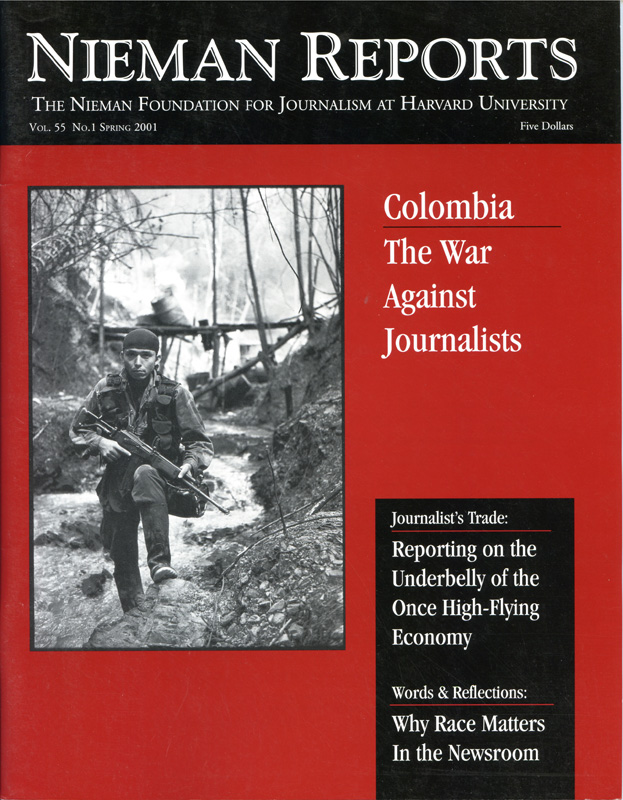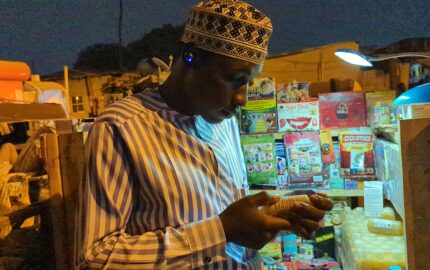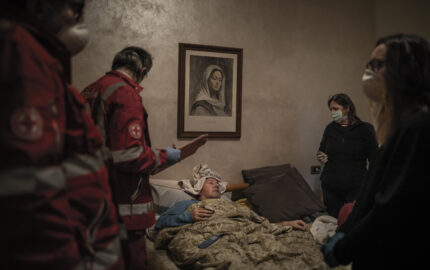
Between 1986 and 1995, 43 journalists were murdered in Colombia, according to the Committee to Protect Journalists (CPJ), which suspects this number is an underestimate since many reported murders of provincial print and radio reporters could not be confirmed. Most of those that could be confirmed were apparent drug-cartel contract murders. As years go by, more violence involves political factions. Here are the names of journalists murdered, attacked, kidnapped and threatened beginning in 1995.
April 5, 1995: Lolita Acosta Maestre, publisher, El Diario Vallenato, escaped unharmed from gunfire but, as a result of the attack, Acosta decided a few months later to stop publication of her newspaper and move to Spain.
April 6, 1995: Six reporters were threatened by alleged members of the Cali drug cartel after reporting appeared on recent anti-drug sweeps in that city. Miguel Angel Arango, editor of the daily El Caleño in Cali, resigned from his job after receiving the threat.
May 8, 1995: Three journalists were attacked and kidnapped by a rebel group and brought to a mountain camp to discuss release of some hostages being held by these leftist rebels and to carry a message to local sugar cane growers. Journalists were prohibited by law from interviewing leftist guerrillas.
August 17, 1995: Ivan Darío Pelayo, manager of radio station Lloanorámica, killed by members of the National Liberation Army (ELN). He was killed when guerillas broke into the studio as Pelayo was broadcasting a program.
November 11, 1995: Gabriel Cruz Díaz, a correspondent for El Heraldo, was stabbed to death by unknown assailants. He was working on a book about the military’s role in Córdoba, an area of Colombia where the government has been battling leftist insurgents.
December 12, 1995: Ernesto Acera Cadena, a veteran reporter, was killed on the street by an unknown assailant who shot him three times and then fled.
January 26, 1996: Three journalists from the Miami-based television channel Univision were threatened with death after an interview aired in which a former minister accused then-President Ernesto Samper of accepting drug money for his presidential election campaign.
March 16, 1996: Raul Benoit, a correspondent for Univision, was shot at by two unidentified gunmen while driving in Bogotá with his wife and children. Benoit had received death threats after filing a series of stories on the Cali drug cartel and the political crisis in Colombia.
May 10, 1996: Ana Lucia Betancur, a reporter for a television news program, was kidnapped by leftist rebels in Cali. She was released unharmed five days later with a message from her kidnappers to the government. The government forbids journalists from carrying any statements made by leftist guerillas.
August 15, 1996: Hector Mujica, a correspondent for El Espectador, was ordered by an armed man to give a verbal explanation of articles he had written about an ambulance set on fire during protests by producers of coca.
August 20, 1996: Two journalists with El Tiempo were threatened by a group of civilians, who forced them to attend a demonstration against a government campaign to prohibit coca cultivation by small-scale local producers.
August 22, 1996: Two television reporters with QAP Noticias were detained by police after covering the occupation of Hacienda Bellacruz by farm workers and later stopped by members of an armed paramilitary group which issued death threats against them.
August 29, 1996: Five journalists were fired upon by soldiers in the Caqueta area of Colombia. The reporters were covering a demonstration by coca cultivators against government prohibitions of small-scale local producers.
August 29, 1996: Luis Gonzalo Velez (“Richard”), a cameraman with a Colombian news program, was beaten repeatedly by three soldiers because of recording soldiers firing on unarmed peasants during a demonstration by coca cultivators. He was forced to flee into exile in the United States after he narrowly escaped being abducted.
October 18, 1996: Norvey Diaz, a director at Radio Colina, was murdered in what CPJ described as a killing “carefully planned by professionals.”
December 16, 1996: A van packed with dynamite exploded outside the home of Juan Gomez Martinez, an owner of the daily El Colombiano. This incident followed a telephoned threat by an anonymous caller who told the newspaper to “keep quiet.”
December 22, 1996: A bomb loaded with 20 kilos of dynamite exploded in Bogotá outside the offices of the weekly Voz, the official publication of the Colombian Communist Party.
December 28, 1996: A bomb containing five kilos of dynamite exploded outside the offices in Medellín of the Bogotá-based daily newspaper El Tiempo. Police speculated that the bomb was planted by members of the guerilla group, the Revolutionary Armed Forces of Colombia (FARC).
March 18, 1997: Freddy Elles Ahumada, a freelance photojournalist (who drove a taxi to supplement his income), was abducted by three unidentified individuals in Cartagena and found assassinated a day later in his cab. His death might have been in reprisal for his photographs of police violence published in El Espectador.
March 20, 1997: Gerardo Bedoya Borrero, opinion editor of the Cali daily newspaper El País and a harsh critic of drug trafficking, was assassinated as he was getting into his car by gunmen who shot him repeatedly. Three weeks earlier, Bedoya wrote a column defending the controversial U.S. decision to decertify Colombia as a recipient of U.S. economic aid because of its government’s alleged ties to cocaine cartels.
November 8, 1997: Francisco Castro Menco, president of the Fundación Cultural, a community foundation that broadcast daily by radio, was shot and killed at home by unidentified killers. His program offered an independent voice for community news in an area of the country where both guerrillas and paramilitary forces are active, and either side might be responsible for his murder.
November 20, 1997: Jairo Elías Márquez Gallego, director of the magazine El Marqués, known for its critical reporting on corruption, was killed in a drive-by shooting while entering his car. He had received numerous death threats during the previous two years because of his crusade against corruption.
February 22, 1998: Oscar García Calderón, a reporter for El Espectador, was shot to death by unidentified individuals. CPJ sources said that García was conducting investigations into the links between bullfighting and organized crime.
March 14, 1998: José Abel Salazar Serna, host of a radio show, was found dead in his apartment. He’d been stabbed 15 times. Salazar had broadcast appeals for peace and coexistence.
April 16, 1998: Nelson Carvajal Carvajal, a highly regarded journalist with Radio Sur, was shot 10 times outside the elementary school where he taught. Local journalists suspect that local government officials (in Pitalito) might have ordered his murder in retaliation for his critical reporting about the former mayor of that town.
May 19, 1998: Bernabé Cortés Valderrama, a reporter with the nightly news program Noticias CVN who reported frequently on topics such as drug trafficking, corruption and negotiations between FARC and authorities about soldiers held by Colombian guerillas, was killed as he was riding in a taxi and pulled up in front of a relative’s home. A CPJ report in 1999 published a report linking drug traffickers to his murder.
August 11, 1998: Ampara Leonor Jiménez Pallares, a former television journalist who had received death threats while working on a documentary about peasants who had been displaced when a government official appropriated land, was shot three times in the head outside her home.
October 14, 1998: Saúl Alcaraz, spokesperson for Instituto Mi Río, an environmental group in Medellín, was shot six times and killed after resisting being forced into a car.
January 7, 1999: Two suspicious-looking men were spotted outside the home of Alfredo Molano Bravo, journalist and columnist for El Espectador. He had received a series of death threats from paramilitary leader Carlos Castaño since publishing an article in July 1998 that linked Colombia’s right-wing paramilitary groups to the violent anti-kidnapping group Death to Kidnappers, which has close links to drug traffickers. Fearing for his life, Molano fled to Spain.
March 24, 1999: Plinio Apuleyo Mendoza, a journalist and columnist with El Tiempo, was sent a book-size mail bomb that exploded in a private mail company’s delivery truck. Mendoza believed he was attacked because of a column in which he accused the attorney general’s office of being infiltrated by members of the ELN (leftist guerrillas). Later in the year, Apuleyo left Colombia for Italy, fearing for his life.
April 11, 1999: Hernando Ragel Moreno, a freelance newspaper and radio journalist, was shot four times in the head. He had regularly denounced the corruption of a local mayor and, just prior to his death, had organized a protest against this mayor.
May 22, 1999: Jorge Rivera Sena, a correspondent for the daily El Universal and a radio network, was kidnapped by individuals believed to be members of a paramilitary unit. He was held hostage for 19 days and released unharmed. Fearing for his life, he moved from where he had been reporting. He continued to receive threats and left for Spain in September.
May 25, 1999: María Cristina Caballero (a 1997 Nieman Fellow), an investigative editor for the weekly SEMANA, received a death threat on her home answering machine. She had interviewed drug traffickers, guerrilla leaders, and the head of Colombia’s paramilitary forces. After hiding for several days, she left the country to live in the United States, where she is writing a book about the conflict in Colombia.
May 27, 1999: Two motorcyclists attempted to run over Jineth Bedoya Lima, a journalist working for El Espectador and several radio stations. She had written about criminal gangs that kidnap people for ransom and had received threats by telephone prior to the attack.
June 8, 1999: Two journalists with RCN Television received death threats after the station aired their footage of policemen ignoring a mob killing. Later that month, one of the journalists was attacked on the street. Within a few months, both journalists had left Colombia.
June 29, 1999: Carlos Pulgarín, correspondent for El Tiempo, received death threats that accused him of being a spokesman for FARC, Colombia’s largest guerrilla movement. He had published articles about the assassination of indigenous activists by right-wing paramilitary forces. Later in the year, he received more death threats and was kidnapped at gunpoint. By year’s end, he had moved to Peru, where he continued to receive death threats—the first known case of a Colombian journalist continuing to face threats while in exile.
July 13, 1999: Two radio reporters received death threats after they exposed corruption within the Cartegena municipal administration.
August 12, 1999: A pamphlet circulated and signed by an ultra-right group called the Colombian Rebel Army included the names of three journalists on a list of 21 people it described as enemies of the peace process.
August 13, 1999: Two motorcycle-riding gunmen murdered political satirist and radio and TV host Jaime Garzón as he was driving to his office. He had regularly traded on his stature as a well respected broadcaster to negotiate for the release of victims of guerrilla kidnappings. He also served on an independent commission that was mediating between the government and the leftist guerrilla group ELN. He had frequently been threatened by Carlos Castaño, the leader of AUC, a right-wing paramilitary group linked to numerous attacks on journalists.
August 15, 1999: Luis López Criollo, a veteran radio journalist, began receiving death threats. The threats grew so persistent that he canceled his radio show on October 30, and he and his family fled the country on Christmas Eve.
September 16, 1999: Two assassins shot and killed Guzmán Quintero Torres, editor of the daily El Pilón. He had recently published an article about an AUC attack on the home of a presumed guerrilla sympathizer, and his prime source was kidnapped and murdered after the story was published.
October 21, 1999: Rodolfo Julio Torres, a radio correspondent, was found brutally murdered. Colleagues are convinced he was assassinated in reprisal for his outspoken reporting and, a year earlier, anonymous pamphlets had accused him of being affiliated with the leftist guerrillas.
October 26, 1999: Henry Romero, a freelance photographer, was kidnapped by members of the National Liberation Army (ELN) and held for nine days. He was kidnapped in retaliation for taking and publishing a photograph of ELN leader Comandante Nicholás without his signature black and red mask.
October 29, 1999: Members of FARC abducted seven television journalists and held them for five days. They were compelled to march long distances to villages where they heard farmers denounce alleged paramilitary atrocities.
November 2, 1999: Alvaro Montoya Gómez, a cartoonist and reporter with El Nuevo Siglo, resigned his position as weekly columnist after receiving anonymous calls that threatened his life and the lives of his children. Even after resigning, Montoya continued to receive threats.
November 10, 1999: Members of FARC kidnapped seven television journalists while they were traveling to cover the aftermath of a right-wing paramilitary attack. They were released in two to four days.
November 14, 1999: A bomb exploded in front of the Cali offices of the Bogotá-based daily El Tiempo, injuring three employees and causing considerable damage. The attack was attributed to either drug traders (angered by Colombia’s policy of extraditing suspected drug traffickers to the United States) or left-wing guerrillas.
December 3, 1999: Pablo Emilio Medina Motta, a TV cameraman, was killed by multiple shots to the head and back when more than 100 leftist guerrillas stormed a town. FARC apologized for the murder, explaining that they had mistaken Medina for a police informer.
December 31, 1999: During 1999, at least 13 Colombian journalists fled the country. A Bogata-based weekly, Semana, described Colombian journalists as “the new displaced.”
May 24, 2000: Ignacio Gómez walked out of his home in Bogotá, got in a taxi, and noticed a man approaching him from behind. Gómez recognized the face as that of a composite sketch of a killer, provided by survivors of a 1997 Mapiripán massacre. In February he had reported that the massacre had been carried out by paramilitaries under the command of Carlos Castaño in concert with Colombian Army forces. Since publication of that story, he’d received 56 threatening letters. A week later, Gómez fled to the United States, where he is currently a Nieman Fellow.
May 25, 2000: Jineth Bedoya Lima, an investigative reporter with El Espectador, was kidnapped outside La Modelo Prison in Bogotá. After being drugged and abducted at gunpoint, she was driven to another city where she was brutally assaulted. She was found 10 hours later in a state of nervous collapse, crawling out of a roadside dump. The likely motive for her kidnapping was the paper’s coverage of an April 27 battle at the prison between common criminals and inmates who belonged to paramilitary factions. She had reported extensively on the prison riots, apparently offending paramilitary leaders at the prison.
October 31, 2000: Juan Camilo Restrepo Guerra, a community radio station director, was shot dead by a suspected right-wing paramilitary gunman. He was apparently murdered in retaliation for his sharp criticism of the local administration.
November 2, 2000: ELN guerrilla fighters kidnapped two television journalists. In exchange for releasing one of the journalists, the guerrilla group called on the government to pledge money for road improvements.
November 15, 2000: Gustavo Rafael Ruiz Cantillo, a radio correspondent, was shot and killed by two gunmen as he crossed a town square. Colleagues said that the gunmen were members of a right-wing paramilitary gang. According to one source, gang members had told Ruiz, who covered politics, crime and general news, to “give up that big mouth’s job.”
December 13, 2000: Alfredo Abad Lopez, director of a radio station, was shot and killed at his home by two suspected paramilitary gunmen.


